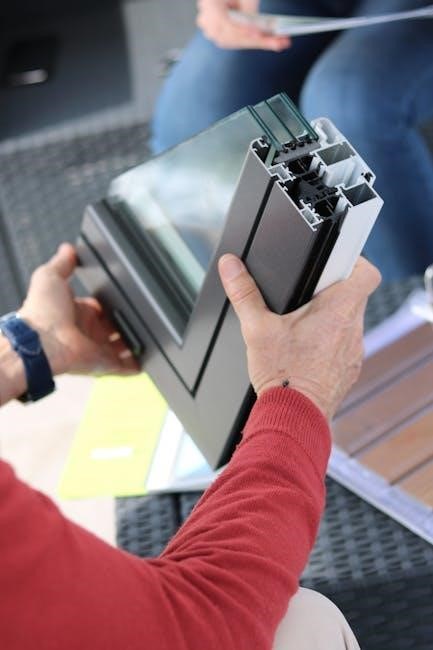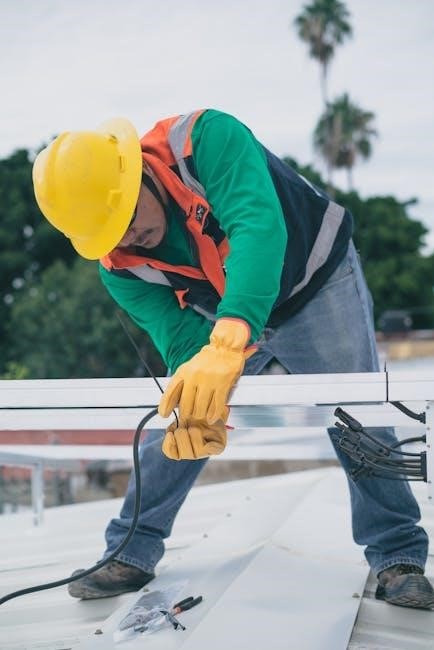The Chamberlain D2101 is a reliable, chain-drive garage door opener designed for standard 7-foot doors, offering smooth operation and compatibility with myQ smart technology;
1.1 Overview of the Chamberlain D2101 Garage Door Opener
The Chamberlain D2101 is a robust, chain-drive garage door opener designed for residential use, compatible with standard 7-foot garage doors and capable of handling doors up to 300 pounds. It features a durable design, quiet operation, and smart connectivity via the myQ app for remote monitoring and control. This model is ideal for homeowners seeking a reliable and affordable solution with modern functionality.
1.2 Importance of Following the Installation Manual
Following the Chamberlain D2101 installation manual is crucial for ensuring safety, proper functionality, and compliance with warranty terms. The manual provides step-by-step instructions to guide homeowners through the process, minimizing risks of errors or accidents. Deviating from the instructions can lead to improper installation, potential damage to the opener or door, and voiding the warranty. Adhering to the manual ensures a smooth, reliable, and long-lasting operation of your garage door opener.

System Requirements and Compatibility
The Chamberlain D2101 is designed for residential use, compatible with standard 7-foot garage doors weighing up to 300 pounds. It supports myQ smart technology for seamless smartphone control.
2.1 Garage Door Specifications for D2101 Compatibility
The Chamberlain D2101 is compatible with standard 7-foot garage doors weighing up to 300 pounds. Ensure the door has proper reinforcement, especially if made of wood or insulated materials. A sturdy top panel or strut is recommended for heavier doors. Compatibility also depends on the door’s spring system, with torsion springs being ideal. Always verify the door manufacturer’s specifications for optimal performance.
2.2 Weight and Size Limits for the Garage Door
The Chamberlain D2101 is designed to handle garage doors weighing up to 300 pounds and measuring 7 feet in height. Exceeding these limits may result in improper function or safety hazards. Ensure your door meets these specifications before installation. For heavier or larger doors, consult the manufacturer or consider additional reinforcement to maintain compatibility and performance.

Tools and Materials Needed for Installation
Essential tools include a step ladder, tape measure, wrench, and screwdrivers. Materials needed are lag screws, hinges, and reinforcement braces for secure installation.
3.1 List of Required Tools
The installation requires a step ladder, tape measure, adjustable wrench, screwdrivers (Phillips and flathead), pliers, and a punch. Optional tools include a drill and socket set for additional adjustments. Ensure all tools are readily available to streamline the process.
3.2 Additional Materials Recommended for Installation
For a seamless installation, consider having extra materials like a 3-button remote control (model 953EV-P2) and a wireless keypad (model 940EV-P2) for enhanced convenience. A reinforcement kit for the garage door is highly recommended for added stability. A drill and socket set may also be useful for adjustments. Ensure all hardware is compatible and readily available to avoid delays. Safety gear like gloves and safety glasses is advised.

Pre-Installation Steps
Before starting, ensure the garage door is balanced and properly aligned to avoid strain on the opener. Always refer to the manual for specific preparation steps.
4.1 Preparing the Garage Door for Installation
Before installing the Chamberlain D2101, ensure the garage door is properly prepared. Check that the door is balanced and aligned to avoid strain on the opener. Remove any existing hardware that may interfere with the new installation. Inspect the door for damage or wear and address any issues. If necessary, reinforce the top panel with a vertical brace for added stability. Ensure the door operates smoothly manually before proceeding. Always consult the manufacturer’s guidelines for specific preparation requirements.
4.2 Ensuring Safety Before Starting the Installation
Before starting the installation, ensure the garage door is disconnected from any existing opener and properly secured. Always follow the safety guidelines outlined in the manual. Check that the Protector System is correctly aligned and functioning. Place warning labels in visible areas and ensure all safety reversal tests are conducted post-installation. Wear protective gear and keep children and pets away during the process;

Installation Process
The installation of the Chamberlain D2101 involves assembling the rail, attaching the motor unit, and securing the header bracket. Follow the step-by-step guide for a smooth setup.
5.1 Step-by-Step Assembly of the Rail and Trolley
Begin by aligning the rail sections and securing them together using the provided hardware. Attach the trolley to the rail, ensuring proper alignment with the chain. Use a socket wrench to tighten all connections firmly. Refer to the manual for specific torque specifications. Double-check that the trolley moves smoothly along the rail before proceeding to the next step.
- Align rail sections carefully.
- Secure the trolley to the rail.
- Tighten all connections with a socket wrench.
- Ensure smooth trolley movement.
5.2 Fastening the Rail to the Motor Unit
Attach the rail to the motor unit by aligning the mounting holes and securing with the provided bolts. Use a socket wrench to tighten evenly, ensuring a snug fit. Double-check the alignment to prevent misinstallation. Refer to the manual for torque specifications to avoid over-tightening, which could damage the motor or rail.
- Align the rail with the motor unit.
- Secure with provided bolts.
- Tighten evenly with a socket wrench.
- Verify alignment and torque specifications.
5.3 Installing the Idler Pulley and Chain
Mount the idler pulley to the garage door frame using the provided bolts, ensuring it’s level and aligned with the motor unit. Attach the chain to both the motor and the pulley, adjusting its length as needed for proper tension. Tighten all connections securely and lubricate moving parts to ensure smooth operation. Refer to the manual for specific torque and alignment guidelines.
- Mount the idler pulley to the frame.
- Attach the chain to the motor and pulley.
- Adjust chain length and tension.
- Lubricate moving parts for smooth operation.
5;4 Mounting the Header Bracket and Motor Unit
Mount the header bracket to the garage ceiling, ensuring it’s centered above the garage door. Secure it with 2-inch lag screws. Hang the motor unit from the bracket using the provided mounting hardware. Ensure the chain is properly aligned and connected to the trolley; Tighten all bolts firmly and double-check the motor’s levelness for optimal performance. Follow the manual’s torque specifications for secure fastening.
- Center the header bracket above the door.
- Secure with 2-inch lag screws.
- Hang the motor unit from the bracket.
- Align and connect the chain to the trolley.

Safety Features and Protocols

The Chamberlain D2101 features the Protector System, including safety sensors that detect obstacles. Ensure proper alignment and connection to guarantee safe door operation and automatic reversal.
- Protector System: Includes infrared sensors for obstacle detection.
- Safety Reversal: Door stops and reverses upon encountering resistance.
6.1 Understanding the Protector System
The Protector System on the Chamberlain D2101 ensures safe operation by detecting obstacles using infrared sensors. Proper alignment and connection are critical for functionality. The system automatically reverses the door if it encounters resistance, preventing accidents. Regular testing is essential to verify its effectiveness. Always follow manual instructions for setup and maintenance to ensure reliable safety performance and compliance with industry standards.
- Infrared Sensors: Detect obstacles in the door’s path.
- Automatic Reversal: Door stops and reverses upon detecting resistance.
6.2 Testing the Safety Reversal System
Testing the safety reversal system ensures the door operates safely. Place an object like a box in the door’s path. Activate the door to close. If it contacts the object, it should stop and reverse. If it fails, check sensor alignment and adjust as needed. Regular testing is crucial for maintaining safety and proper functionality. Always refer to the manual for detailed testing instructions.
- Test Object: Use a sturdy object to trigger the reversal.
- Alignment Check: Ensure sensors are properly aligned for accurate detection.

Troubleshooting Common Installation Issues
Identify and resolve common issues like rail misalignment, chain tension problems, or sensor connectivity. Refer to the manual for detailed solutions and step-by-step guides.
- Rail Alignment: Ensure proper alignment for smooth operation.
- Chain Tension: Adjust as needed to prevent motor strain.
7.1 Resolving Alignment Problems with the Rail
If the rail is misaligned, the garage door may not open or close properly. To fix this, loosen the lag screws, adjust the rail to ensure it is level, and retighten the screws. Use a spirit level to verify alignment. If the rail sags, tighten the chain or consult the manual for additional adjustments. Proper alignment ensures smooth operation and prevents motor strain.
- Loosen lag screws to adjust rail position.
- Use a level to ensure proper alignment.
- Retighten screws and test the door.
7.2 Fixing Chain Tension and Motor Unit Connectivity
Adjusting the chain tension and ensuring motor connectivity are crucial for the D2101’s performance. To fix chain tension, locate the tension adjustment nut near the motor. Turn it clockwise to tighten or counterclockwise to loosen. Avoid over-tightening to prevent motor strain. For connectivity issues, inspect wiring connections between the motor and control panel. Ensure all wires are securely attached. If problems persist, reset the motor by unplugging it for 30 seconds. Proper alignment of the Protector System sensors is also essential for smooth operation.
- Adjust chain tension using the adjustment nut.
- Check and secure all wiring connections.
- Reset the motor if necessary.
- Ensure sensor alignment for proper connectivity.

Final Testing and Adjustment
After installation, perform a full safety reversal test and adjust limit switches to ensure smooth operation. Verify proper alignment and connectivity for optimal performance.
- Test safety reversal system thoroughly.
- Adjust limit switches for precise door movement.
- Ensure all components are securely connected.
8.1 Performing a Full Safety Reversal Test
To ensure the garage door opener operates safely, perform a full safety reversal test. Place an object under the door, then activate the opener. The door should reverse direction upon contact. If it fails, adjust the sensitivity settings on the motor unit and repeat the test. Proper alignment of the Protector System is crucial for this feature to function correctly. Always follow the manual’s instructions for precise adjustments.
8.2 Adjusting the Limit Switches for Smooth Operation
Adjusting the limit switches ensures the garage door opens and closes fully. Loosen the adjustment screws on the motor unit, then move the switches to align with the door’s travel path. Tighten the screws and test the door’s operation. Proper adjustment prevents over-travel or under-travel, ensuring smooth and consistent performance. Always refer to the manual for specific instructions to avoid malfunctions.

Maintenance and Upkeep
Regular maintenance ensures optimal performance and longevity of the Chamberlain D2101. Lubricate moving parts annually and inspect the chain for tension and wear.
9.1 Regular Maintenance Tasks for Optimal Performance
Regular maintenance is crucial for ensuring the Chamberlain D2101 operates smoothly. Lubricate all moving parts, such as the chain and rollers, annually to reduce friction and wear. Inspect the chain for proper tension and adjust if necessary to prevent misalignment. Additionally, check the garage door balance and alignment to avoid unnecessary strain on the motor. Cleaning the photo-eye sensors and ensuring they are properly aligned is also recommended to maintain safety features. Finally, test the door’s operation periodically to identify and address any potential issues early.
9.2 Lubricating Moving Parts and Checking Chain Tension
Lubricate the chain, rollers, and hinges with a silicone-based spray to ensure smooth operation. Inspect the chain for proper tension; if loose, adjust the tension by turning the tension bolt. Tightening the bolt clockwise increases tension, while counterclockwise loosens it. Always refer to the manual for specific lubrication points to avoid damage. Proper lubrication and chain tension are essential for extending the opener’s lifespan and maintaining efficiency.
Warranty and Support Information
The Chamberlain D2101 is backed by a limited warranty covering parts for a specified period. Register your product on Chamberlain’s website for updates and support. Visit www.chamberlain.com for assistance or to contact their customer support team.
10.1 Understanding the Chamberlain Warranty Terms
Chamberlain offers a limited warranty for the D2101, covering parts for a specified period. The warranty ensures replacement or repair of defective parts. Visit their official website for details.
10.2 Contacting Chamberlain Support for Assistance
For any inquiries or issues with the D2101, Chamberlain provides multiple support channels. Visit their official website, www.chamberlain.com, for detailed contact information, including phone support, email options, and live chat. Additionally, users can access assistance through the myQ app or by referring to the installation manual for specific support resources. Prompt and reliable help is available to address all concerns.
Additional Resources
For enhanced convenience, Chamberlain offers the myQ App for smart garage control and the BILT App for 3D installation guidance.
11.1 Accessing the myQ App for Smart Control
Download the myQ App from the App Store or Google Play to control your Chamberlain D2101 garage door opener remotely. The app allows you to monitor, open, and close your garage door from your smartphone. Ensure your opener is connected to Wi-Fi and follow in-app instructions to pair it with your device for seamless smart control.
11.2 Downloading the BILT App for 3D Instructions
Download the free BILT App from the App Store or Google Play for interactive 3D instructions tailored to your Chamberlain D2101 installation. This app provides a step-by-step visual guide, making complex tasks easier to understand. Once installed, search for the D2101 model to access detailed assembly and installation animations for a flawless setup experience.
The Chamberlain D2101 installation process is complete. Ensure all safety features and functionalities are tested for optimal performance and secure garage door operation.
12.1 Summary of the Installation Process
The Chamberlain D2101 installation involves assembling the rail and trolley, fastening components, installing the idler pulley, and mounting the header bracket. Ensure proper alignment and chain tension for smooth operation. Conduct safety tests, including the Protector System and reversal test, to confirm functionality. Follow manual instructions carefully to achieve a secure and efficient garage door opener setup. Proper installation ensures long-term reliability and safety.
12.2 Final Tips for a Successful Installation
Ensure all bolts and screws are securely tightened and double-check chain tension for optimal performance. Use the BILT app for 3D installation guidance if needed. Test the garage door opener thoroughly, including the safety reversal system. Regularly lubricate moving parts and inspect the chain for wear. Refer to the manual for maintenance schedules and troubleshooting tips to ensure long-term functionality and safety.
